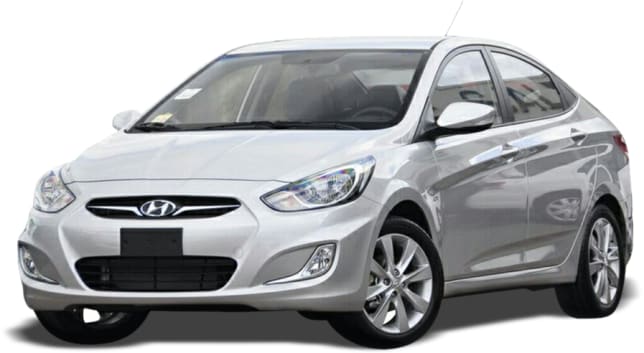
Small Cars 2012 Review
- Mazda 2
- Hyundai Accent
- Toyota Yaris
- Ford Fiesta
- Ford Fiesta 2012
- Hyundai Accent 2012
- Toyota Yaris 2012
- Mazda 2 2012
- Mazda 2 Reviews
- Hyundai Accent Reviews
- Toyota Yaris Reviews
- Ford Fiesta Reviews
- Ford Reviews
- Hyundai Reviews
- Mazda Reviews
- Toyota Reviews
- Ford Hatchback Range
- Ford Sedan Range
- Hyundai Hatchback Range
- Hyundai Sedan Range
- Mazda Hatchback Range
- Mazda Sedan Range
- Toyota Hatchback Range
- Toyota Sedan Range
- Hatchback
- Sedan
- Ford
- Hyundai
- Mazda
- Toyota
- Small Cars
- First Car
- Budget cars
A decade ago you wouldn't consider a motoring holiday in a light passenger car. Too small, too noisy, too bumpy and stripped of any comfort feature demanded by the long-distance motorist. The only time you'd crack a smile is when refuelling - if the range of the tiny petrol tank allowed you to get there. But I'd take any of these four hatches - Hyundai Accent, Mazda 2, Toyota Yaris or Ford Fiesta - out to Alice Springs, have a coffee at Gonzo's, and drive back. You wouldn't have done that in most of the lightweight hatches sold 10 years ago.
What's changed? You. You are now demanding fuel efficient, safe and roomy baby cars that slot under a Corolla but just above the pared-back, minicar budget class.
Manufacturers are falling over themselves in the challenge. They know you are downsizing but don't want to lose luxury and convenience features. They know you are focused on fuel economy and safety, like a space in a comfortable cabin and demand premium things like audios that integrate with handheld devices.
There are more than four hatchbacks to choose from. In fact there are 26 distinct models in the light-car segment. But the four listed here are very, very good at their job. They will suit the commuter as much as the uni student, have sufficient zip for driver's with passion, the simplicity of driving to lure Mum and the cabin and boot room for junior and the pram.
These four tested here are all the top-spec in their model range. They are all automatic, all have the maximum five-star crash ratings and five lap-sash seatbelts, and are similarly priced. They're just small - that's all.
1. HYUNDAI ACCENT Premium ($22,990)
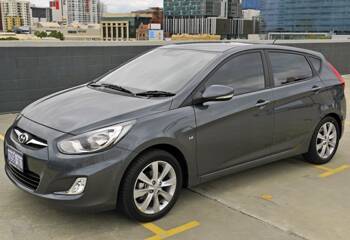
Slips above the i20 and just below the i30 (which gets bigger next year with a new model) in size and price but loses nothing in terms of comfort, space and features. Possibly the best of the three sisters, it wears the latest Hyundai style yet is suitably restrained to broaden its market.
Value
Star: 4: Wins the race here with heaps of features for the price in comparison to the others. Leather upholstery; compatible audio with Bluetooth, iPod and USB; full-size spare alloy wheel; keyless start; electric windows and mirrors; four-wheel disc brakes; and a lidded centre console are included.
Design
At 4.1m long it's not tiny but the snub nose, abrupt tail and height give it distinction. It all translates into excellent cabin room - a close second for rear legroom - and a big boot. How Hyundai fits a 195mm wide full-size spare under the boot floor and still manages to beat most rivals is simply clever.
Technology
It's a simple car with the accent (that's a pun) on low running costs. So the 91kW/156Nm 1.6-litre engine is made for durability and the four-speed auto - with sequential shift - is built to be inexpensive and reliable. The electric steering can be vague and even uncertain so requires familiarisation.
Safety
Five-star crash rating, six airbags, electronic stability and traction control, four-wheel disc brakes, rear park sensors and even a camera with its screen in the rear vision mirror. Complete.
Driving
Only the vague and twitchy electric steering dampens a confident, peppy and comfortable ride. The engine is flexible enough to cope with only four gears - though the sequential mode can add sparkle - and is relatively quiet, economical and even entices a level of fun to driving. Handling is typical of its class and will surprise with its surefootedness. Great visibility (rear camera helps here) and comfortable leather seats help survive the city.
2. MAZDA2 Genki ($22,145)
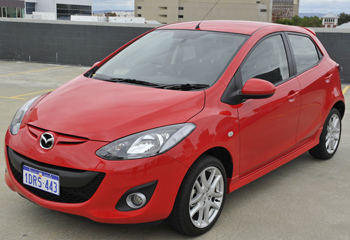
This model gets better each year and is now the most popular in its segment with a 13.6 per cent share. The Genki is the top-line of the Mazda2 range and continues to add more comfort and features to make many buyers think twice before going up a size to the Mazda3. This is a small car - at 3.9m long, the second smallest here - so is suggested for single drivers or perhaps couples.
Value
Over the mid-level Mazda2 Maxx, Genki costs $2805 more and adds cruise control, body kit, bigger 16-inch alloys, trip computer, auto headlights and climate-control airconditioning. Worth it? Probably not, though if you're a leadfoot, the cruise control may save the difference in speeding fines within the first year.
Design
Cute. Everyone loves these but they are definitely styled to attract women. Get out of the car, Brian. Mazda cleverly doesn't overdo the family-themed styling so the baby car has subtle looks yet remains distinctly zoom-zoom. It's small size doesn't stop design flexibility - the vertical glovebox has an open top to store A4 documents which is handy if you have A4 documents, a bit daft if you do not. The rear seat is better for children than adults and though the boot is only 250-litres, split fold rear seats give some load-space flexibility.
Technology
Again, this is a simple sector of the car market and Mazda complies with a 1.5-litre engine and four-speed automatic transmission. No surprises here. It has front disc brakes but the rear units are drum - see also Fiesta and Yaris - which is serviceable but old hat. Suspension is common to the four - MacPherson struts at the front and a torsion bar at the back - based on low price and compactness.
Safety
Also a five-star crash rated car. The Mazda2 equals most rivals with its six airbags, electronic stability and traction control, brake assist and brakeforce distribution. The space-saver spare wheel loses some points - compared with the Hyundai - so can limit its ability to take to the country.
Driving
This is the oldest model here yet still delights with its performance and particularly its agile handling. Like the others it has electric steering but seems more communicative than most. The drum rear brakes don't affect performance and, surprisingly, the engine copes very well with the miserable four cogs offered in its gearbox. It really is a joy to drive but can be noisy and if you have too much fun, fuel thirst will kill the smiles.
3. TOYOTA YARIS YRX ($21,390)
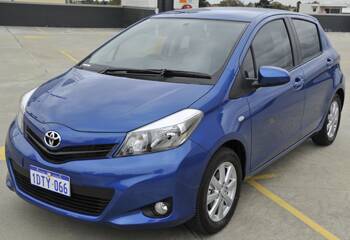
The second generation Yaris - following on from the Echo - improves by evolution to become bigger and stronger. It is making a step away from the "cutesy" end of the segment and looks bolder. In doing so, it will appeal equally to male and female buyers. But despite its new look, much of the car remains similar to before and may not appear to offer as much value as its most deadly rival, Hyundai.
Value
The price is good. This is the cheapest car here by up to $1600 and probably not what you'd expect from Toyota. It's pretty well specced with 15-inch alloys, auto headlights, touch-screen audio with sat-nav, Bluetooth and USB/iPod compatibility, climate airconditioning and trip computer. The YRX is $2000 more than the mid-spec but aside from the SUNA traffic system - not available in all states - I can't see the value in the extra loot.
Design
As mentioned, this model arrived a couple of months ago with a more masculine style and boasting more cabin room. The deep V-shaped grille and kerb-catcher bottom inlet are striking, as is the bulging rear wheel arches and pronounced tail lights. Inside it's a very good match of ergonomics and aesthetics. The double-layer boot looks cavernous but is only a snip above the Mazda2. But rear legroom is the best in this comparison so this car has more flexibility than most.
Technology
The YRX gets the bigger 80kW 1.5-litre engine which has been around, in various guises, for a while. Most others get a 63kW 1.3-litre unit. No problem with the 1.5's power delivery and even the four-speed auto doesn't cripple its verve. The electric steering is pretty good but the drum rear brakes appear at odds with the rest of the car.
Safety
Again, a five-star crash rating with seven airbags (the seventh is for the driver's knees), electronic stability and traction control, brake assist and brakeforce distribution. The spare wheel is a space saver.
Driving
This is a tidy car. It sits nice and flat on the road and produces no squirms through the bends. The engine is sufficiently flexible to dust off the four gears and though it's no sports car, you can have a lot of fun here. The ride quality is also tops with comfortable seats and forgiving suspension, but it's not the quietest of the bunch and tyre noise can become annoying. Visibility is reasonable. It is difficult to get the complete rear view because of the rear-seat head restraints and to forward vision is thwarted by the steep rake of the bonnet. There is also no park sensors so parking can be guesswork.
4. FORD FIESTA Zetec ($22,990)
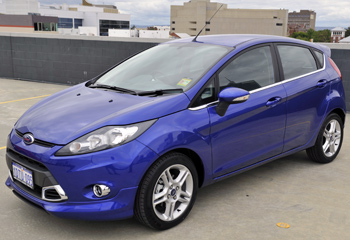
Ford have a little beauty on its hands with the Fiesta. It's so good that in many ways, trumps the bigger - and newer - Focus. It's made in Thailand (like the Mazda2) but quality rates highly. The Zetec is the most expensive of the range that also includes sedan versions and the frugal small-bore diesels.
Value
The price compares favourably with the others. Ford has a $2000 gap between the five-door hatch models - from the CL at $16,990 to LX at $18,990 and then the manual Zetec at $20,990 - and the latter justifies the extra with sports suspension, 16-inch alloy wheels, cruise control, sports seats and is the only one with USB and iPod integration in the audio. Yes, it's worth the extra.
Design
Like the rivals, hard plastic dominates the dashboard and most remaining cabin spaces. But it's all been tastefully executed and though a bit busier than, say, the Hyundai or Mazda, delights in its playground appeal. The Focus-style audio buttons are a bit small for some fingers and there's no lid on the centre console (though the Fiesta isn't alone here) while the exterior is distinctive and fresh.
Technology
Nothing to thrill here except the brilliant six-speed dual-clutch automatic. The six gears gives a wide spread in which the engine can work more efficiently while giving rapid upchanges. Very sporty. The 1.6-litre engine is a pleasant unit but nothing really to write home about, while the Fiesta follows suspension convention with MacPhersons at the front and a torsion beam behind.
Safety
I repeat - five-star crash rating. There's also all the same electronic aids as the other competitors here and the only glaring difference is that the Fiesta doesn't come with a spare wheel. Nada. Zip. Nothing. Just a bottle of aerosol goo to reinflate the punctured tyre. A spare is optional and is a mandatory purchase.
Driving
The gearbox makes this car. It adds sparkle to the engine, creates smoother driving and ensures the engine is always in an efficient and torquey band of power through the corners. But there's actually a bit more. The seats are supportive and the small steering wheel falls nicely to hand, so there's the feeling that you're in a sports car and even though it's a city hatchback, it has a healthy 89kW/151Nm and records the lowest fuel consumption. Nothing much to dislike here though the boot is almost Mazda2 class in its size.
Pricing guides
Range and Specs
| Vehicle | Specs | Price* | |
|---|---|---|---|
| Active CRDi | 1.6L, Diesel, 4 SP AUTO | $6,490 – 9,130 | 2012 Hyundai Accent 2012 Active CRDi Pricing and Specs |
| Active | 1.6L, ULP, 4 SP AUTO | $6,600 – 9,350 | 2012 Hyundai Accent 2012 Active Pricing and Specs |
| Active | 1.6L, ULP, 5 SP MAN | $4,950 – 7,260 | 2012 Hyundai Accent 2012 Active Pricing and Specs |
| Active CRDi | 1.6L, Diesel, 4 SP AUTO | $6,050 – 8,470 | 2012 Hyundai Accent 2012 Active CRDi Pricing and Specs |
$2,985
Lowest price, based on 45 car listings in the last 6 months















